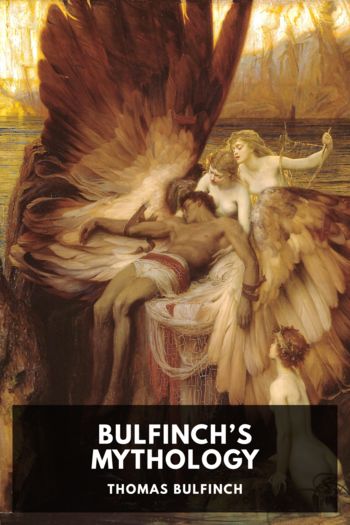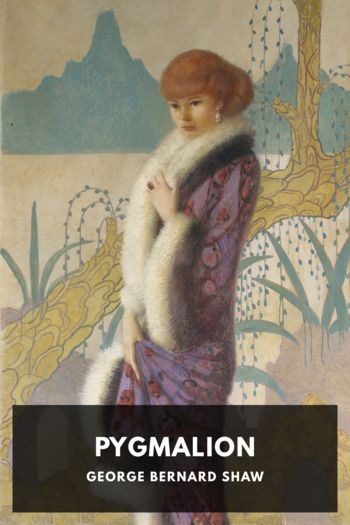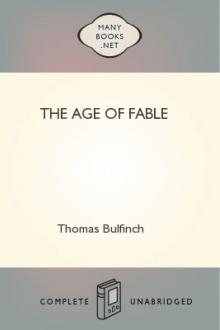Bulfinch’s Mythology, Thomas Bulfinch [love story books to read txt] 📗

- Author: Thomas Bulfinch
Book online «Bulfinch’s Mythology, Thomas Bulfinch [love story books to read txt] 📗». Author Thomas Bulfinch
Ogier, the Dane, is a real personage. History agrees with romance in representing him as a powerful lord who, originally from Denmark and a Pagan, embraced Christianity, and took service under Charlemagne. He revolted from the Emperor, and was driven into exile. He afterwards led one of those bands of piratical Northmen which ravaged France under the reigns of Charlemagne’s degenerate successors. The description which an ancient chronicler gives of Charlemagne, as described by Ogier, is so picturesque, that we are tempted to transcribe it. Charlemagne was advancing to the siege of Pavia. Didier, King of the Lombards, was in the city with Ogier, to whom he had given refuge. When they learned that the king was approaching they mounted a high tower, whence they could see far and wide over the country. “They first saw advancing the engines of war, fit for the armies of Darius or Julius Caesar. ‘There is Charlemagne,’ said Didier. ‘No,’ said Ogier. The Lombard next saw a vast body of soldiers, who filled all the plain. ‘Certainly Charles advanced with that host,’ said the king. ‘Not yet,’ replied Ogier. ‘What hope for us,’ resumed the king, ‘if he brings with him a greater host than that?’ At last Charles appeared, his head covered with an iron helmet, his hands with iron gloves, his breast and shoulders with a cuirass of iron, his left hand holding an iron lance, while his right hand grasped his sword. Those who went before the monarch, those who marched at his side, and those who followed him, all had similar arms. Iron covered the fields and the roads; iron points reflected the rays of the sun. This iron, so hard, was borne by a people whose hearts were harder still. The blaze of the weapons flashed terror into the streets of the city.”
This picture of Charlemagne in his military aspect would be incomplete without a corresponding one of his “mood of peace.” One of the greatest of modern historians, M. Guizot, has compared the glory of Charlemagne to a brilliant meteor, rising suddenly out of the darkness of barbarism to disappear no less suddenly in the darkness of feudalism. But the light of this meteor was not extinguished, and reviving civilization owed much that was permanently beneficial to the great Emperor of the Franks. His ruling hand is seen in the legislation of his time, as well as in the administration of the laws. He encouraged learning; he upheld the clergy, who were the only peaceful and intellectual class, against the encroaching and turbulent barons; he was an affectionate father, and watched carefully over the education of his children, both sons and daughters. Of his encouragement of learning we will give some particulars.
He caused learned men to be brought from Italy and from other foreign countries to revive the public schools of France, which had been prostrated by the disorders of preceding times. He recompensed these learned men liberally, and kept some of them near himself, honoring them with his friendship. Of these the most celebrated is Alcuin, an Englishman, whose writings still remain, and prove him to have been both a learned and a wise man. With the assistance of Alcuin, and others like him, he founded an academy or royal school, which should have the direction of the studies of all the schools of the kingdom. Charlemagne himself was a member of this academy on equal terms with the rest. He attended its meetings, and fulfilled all the duties of an academician. Each member took the name of some famous man of antiquity. Alcuin called himself Horace, another took the name of Augustin, a third of Pindar. Charlemagne, who knew the Psalms by heart, and who had an ambition to be, according to his conception, a king after God’s own heart, received from his brother academicians the name of David.
Of the respect entertained for him by foreign nations an interesting proof is afforded in the embassy sent to him by the Caliph of the Arabians, the celebrated Haroun al Raschid, a prince in character and conduct not unlike to Charlemagne. The ambassadors brought with them, besides other rich presents, a clock, the first that was seen in Europe, which excited universal admiration. It had the form of a twelve-sided edifice with twelve doors. These doors formed niches, in each of which was a little statue representing one of the hours. At the striking of the hour the doors, one for each stroke, was seen to open, and from the doors to issue as many of the little statues, which, following one another, marched gravely round the tower. The motion of the clock was caused by water, and the striking was effected by balls of brass equal to the number of the hours, which fell upon a cymbal of the same metal, the number falling being determined by the discharge of the water, which, as it sunk in the vessel, allowed their escape.
Charlemagne was succeeded by his son Louis, a well-intentioned but feeble prince, in whose reign the fabric reared by Charles began rapidly to crumble. Louis was followed successively by two Charleses, incapable princes, whose weak and often tyrannical conduct is no doubt the source of incidents of that character ascribed in the romances to Charlemagne.
The lawless and disobedient deportment of Charles’s paladins, instances of which are so frequent in the romantic legends, was also a trait of the declining empire, but not of that of Charlemagne.
The Peers, or PaladinsThe twelve most illustrious knights of Charlemagne were called Peers, for the equality that reigned among them; while the name of Paladins, also conferred on them, implies that they were inmates of the palace and companions of the king. Their names are always given alike by the romancers, yet we may





Comments (0)